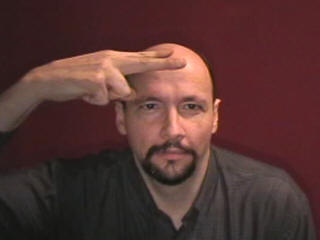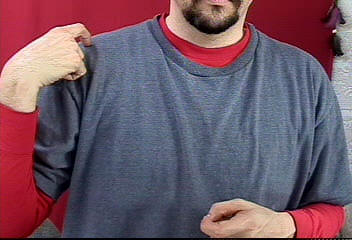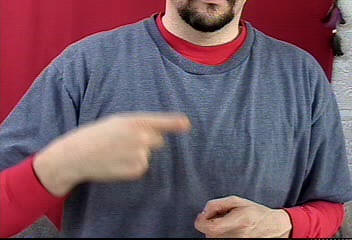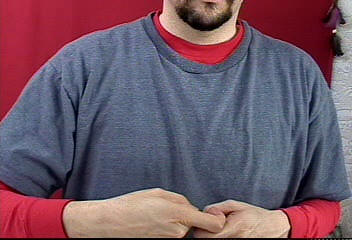American Sign Language: "Mexico"
Also see the sign for SPAIN
Here's a "V-hand" version of the sign for Mexico that eplaced an older sign done with two X-hands.
This newer sign spread through a period of about 20 years and became the "politically correct" version of the sign for "Mexico."
(Update: This is still true as of 2023).
I first saw this sign around 2001 to 2003 while living down in South East Texas. It was shown to me by a Deaf Mexican who was a sign language teacher (who lived in Mexico). He was visiting Lamar University as part of an outreach event.
This is a very good sign for Mexico since it (or a variation of it) is used by many Mexicans to refer to their country.
Hold a "V" hand up near your forehead and swing it forward twice as if showing the front part of a sombrero (Mexican hat).
MEXICO (politically correct version)
Note: You may also see a single movement version -- especially in compound concepts and/or in the middle of a sentence during high speed signing.
A bit of history for you:
For many years ASL signers used the following sign to mean either MEXICO or SPAIN. The specific meaning depended on context.
It was a very widespread sign, used by many people to mean either of those two concepts. Many still use this sign to mean Spain or Spanish (but there are other versions of Spain as well -- so stay flexible).
MEXICO (old version)
Both hands are forming the letter X in the ASL manual alphabet. The X (crooked index finger) of the dominant hand is brought down to be on top of the X (the crooked index finger) of the non-dominant hand.
Hello Jim,
Notes:
11/02/2023:
On a video clip of a version of the sign for Mexico using a "V" hand near the forehead making a double movement a viewer commented:
"The movement is wrong, only should move once."
(See: https://youtu.be/9hDYv623eyM)
Response from Bill:
I believe if you research this a bit you will notice that the sign has evolved.In ASL and as used by many international signers the concept of Mexico is often signed with a repeated movement. The video clip you are commenting on is one example of one version of the sign for Mexico. Yes, sometimes Mexico is signed with a single movement in ASL but not always. It seems as time passes the sign has evolved to (in many cases) use a double movement (in ASL) on the hand of many signers.
I am totally okay with people signing a single movement version of Mexico -- especially in the middle of a sentence at high speed -- but to claim that a double movement version is wrong is to ignore reality. In real life it is very common to see Mexico signed with a double movement in many places in the world and particularly in the U.S.
I'm going to provide examples to you of skilled Deaf signers and ASL interpreters doing the sign for Mexico. If you put in the effort to watch the videos you will notice they are using a repeated movement. So, forgive me but I disagree with your opinion and so do many others.
See the 1 minute 32 second mark of this video: https://youtu.be/AdDxgNZ7nC0?t=91
Notice that the news announcer (Alex Abenchuchan / Deaf) signs Mexico using a double movement.
Alex does it again at the 2 minute and 48 second mark of this video:
https://youtu.be/fTpH5m4OTw4?t=167
A different news announcer signs Mexico using a repeated movement at the 6 minute and 9 seconds mark of this video:
https://youtu.be/lYv-muFxnxg?t=367
At the 18 second mark of this video we see the sign Mexico done by Rogan Shannon with a quick double movement:
https://youtu.be/AgT1uAF_Ojg?t=15
On the international scene at the 8 minute and 23 second mark of this video we see Mexico signed with a double movement:
https://youtu.be/DHAyIJ7WffA?t=503
We see yet another signer at the 9 minute and 43 second mark of this video signing Mexico using a double movement: https://youtu.be/g_uliqK-4ow?t=583
At the eight minute and 21 second mark of this video we see yet another signer doing Mexico with a double movement:
https://youtu.be/2YAeiOg-klo?t=500
At the 8 minute and 16 second mark of this video we see a White House interpreter signing Mexico using a double movement:
https://youtu.be/rcQGfsLqJ8Y?t=496
At the 32 m 20 s mark of this video we see another White House interpreter using a multiple movement version of Mexico -- this fellow actually does THREE movements.
https://youtu.be/j88qi-sykWo?t=1936
At the 5 m 52 second mark of this video we see yet another signer use a repeated movement for Mexico:
https://youtu.be/w-LcbXCiwTg?t=350
At the 23 m 48 s mark of this video we see a courtroom interpreter using a double movement sign for Mexico:
https://youtu.be/ZgvLTS2zJdo?t=1418
At the 3m 41 mark of this video we see another signer doing Mexico using a repeated movement:
https://youtu.be/6mJ4PO4iZT4?t=221
At spreadthesign.com we see Mexico demonstrated using a repeated movement:
https://media.spreadthesign.com/video/mp4/13/455347.mp4
At handspeak.com we see the sign Mexico demonstrated using a repeated movement:
https://www.handspeak.com/word/m/mex/mexico-isl.mp4
I could provide more examples but it would be a waste of time. If after seeing a dozen examples of the sign done with a repeated movement by a variety of skilled signers doesn't convince you that the double movement version is a legitimate variation then there is no point in providing more examples.
I wish you well in your journey and I encourage you to do more research and observation.
In a message dated 9/6/2007 6:16:29 P.M. Pacific Daylight Time, an ASL instructor writes:Bill,
I find your site remarkably accurate for ASL, and I recommend it to my ASL students as a reference. (your fingerspelling link is especially handy) Today, however, one of my students came in to class with a sign for MEXICO that she found on your site. I told her that although I've been signing and studying ASL for over 30 years I'd never seen the sign she showed me. So I just now went to your site and looked it up. I've never seen that one, ever. The one we all use around here - and the only one I've seen (except for the older politically uncorrect version of bandit) is using one or two X-shapes coming from your shoulder(s) back down to the non-dominant hand that is also X-shaped held out in front of your body. I can't believe you haven't seen that one in Sacramento and resorted to using a sign that someone from Texas showed you. But I tend to be very open-minded about variations and will file that one away.
Just thought I'd throw in my two cents.
Jim
Thanks for bringing this up for discussion.
You make an excellent point regarding the popularity and current dominance of the "X"-handshapes_("shawl") version of the sign for Mexico.
I used the "shawl" ("x" handshapes) sign for many years and it certainly still belongs on the "Mexico" page as the citation (main) form, with the "V" sign-(representing a sombrero) listed as a neologism (emerging sign).
Note: The "V"-handshape sign-(representing a sombrero) is spreading very rapidly as a "new" politically correct sign for Mexico because many Mexican people use it as their preferred sign to refer to their own country. I think it is important to point out that it wasn't a "Texan" that showed me the sign, it was a Deaf Mexican Sign Language instructor who was visiting Lamar University from Mexico. I would venture to predict that within 10 years the "V"-hand version will be the dominant variation in the United States as well. Time will tell.
I appreciate your time and feedback.
Cordially,
Bill
In a message dated 9/8/2007 10:31:23 A.M. Pacific Daylight Time, Jim (an ASL instructor) writes:Hey Bill,
Thanks for clearing that up. I appreciate your thinking.
So the deaf guy you learned it from was teaching MSL. I don't see how referencing a sombrero is any less offensive than a serape. I don't think I'll live long enough to see if your prediction comes true. And don't get me started about all the new politically correct signs . . . Takes a long while for those variations to get to the rank and file Deaf people.
Although I must admit that I first learned the bandito version of the sign for Mexico way back when - the M handshape with mask - and the pushed nose version for blacks - so I guess I've bowed to political correctness myself. If it takes over and predominates, then I'll use it. I just can't warm up to some of the new signs such as Japan. China and Africa but I see them used more and more. As you say, time will tell. It's very interesting to review the various changes in ASL over the many years I've been studying it. I'm sure there's a book or research that's already looked at this - I even probably read it at one time.
Hell, now I owe it to my students to teach them the PC sign for Mexico. And inform them of it's derivation.
Thanks again - it's good to discuss these things with someone with your brains and background.
Jim
Jim,
In the "for what it's worth" column, I went to work the next day and asked (separately) the first two co-workers I ran into how they signed M-E-X-I-C-O.
Sandra Thrapp (Deaf, 20 years as an ASL instructor) replied with the "sombrero" sign and proceeded to show the "serape" and "bandit" signs as well.
Jennifer Rayman, (Hearing, Ph.D., studied under Carol Padden at UCSD) also showed the "sombrero" sign as her first choice. So I reckon you might end up living long enough after all. I think the "sombrero" version will spread quickly since it helps "disambiguate" (clear up) the "serape/Mexico/Spain" sign.
Grin.
--Bill
Dr. Bill,
Well, you are a thorough guy. I stand corrected. I know Carol Padden and I trust your sources as authentic. I will include this sign from now on. I'm impressed that you did your own impromptu survey. I will do the same soon myself.
I'm not sure what you mean by your last comment - Are you saying that this sign is only used for MEXICO and not for Spain? If it is just an alternate version for MEXICO/SPAIN/SPANISH/MEXICAN how does it "disambiguate?" - gee, I also learned a new English word from you. You're a wealth of knowledge.
- Jim
Jim,
Indeed, the new "MEXICO" sign (the "sombrero" - (V hand) version of the sign for "Mexico") only means "Mexico" and does not refer to Spain. So now we have a sign for Mexico that will not be confused with "Spain" and doesn't need to rely on context or lip movement.
The "serape"-(X hand) sign for Mexico was ambiguous.
--Bill
[Note: I do not know whether Carol uses the "sombrero"-(V hand) sign or not. I'll have to ask her next time I see her. I was simply pointing out that Jennifer studied under someone competent. Jennifer (Dr. Rayman) is well traveled and has taught in England as well as here in the States.]
Dr. Bill,
I'm a non-Hispanic, 30(+)-year Spanish-speaking, 20-year resident of San Antonio, Texas, former employee of Mexicana de Aviación, and a beginning ASL student at San Antonio College.Jim said: <<So the deaf guy you learned it from was teaching MSL. I don't see how referencing a sombrero is any less offensive than a serape. >>
I found the above statement interesting and perhaps can shed a little "luz" (light).
The sombrero, in my observation, is a sign of pride in Mexican culture and heritage. It is worn by charros, escaramuzas, mariachis, and popular singers, to name just a few. See references below signature.
I'm guessing that the derivation of the MSL sign for Mexico is a reference to this cultural pride. The sombrero sign is clearly different from the shawl/serape/flag signs used for Spain or Spanish. It's also non-gender-specific, compared to the "mustache" sign.
As we celebrate Hispanic Heritage Month, we can respect the diversity of the Spanish-speaking community in both spoken and signed language. Now to find the signs for Venezuela, Argentina, Puerto Rico...!
Yours multi-lingually,
Gilder Anne McCarroll
Known as "Gilder"
baterista9(at)aol.com
San Antonio, TX, USA
Note the references to sombreros in the information below:
<<... the parade is a serious event for the charro. Each charro is dressed in his finest, with matching pants, jackets, bows, boots and sombreros.>>
<<The women in the parade are called escaramuza, highly trained not only in horse"man"ship but also recognized for beauty, skill, grace and poise. ... Dresses are full, allowing the women to ride traditional European side-saddle. Ankle boots are worn, matching their full sombrero.>>
Source: Vallarta Online | News | Charro Day
-------------------------
<<When for the first time mariachis could afford to outfit themselves elegantly, they chose the suit of the horseman or traje de charro. The gala version of this suit wom by contemporary mariachis-with its tightly-fitting ornamented pants, short jacket, embroidered belt, boots, wide bow tie, and sombrero-was once the attire of wealthy hacienda owners. [see charro).>>
Mariachi Tradition
<<More than just the undisputed king of Mexico's traditional ranchera music, Vicente Fernández -- "El Idolo de Mexico" -- is one of that country's most recognizable and influential cultural icons. >>
<<With his supersized sombreros, prominent black mustache, and eye-popping costumes, ..., the glitzy Fernández on-stage is an imposing, larger-than-life figure.>>
Source: Vicente Fernandez Biography - AOL Music
In a message dated 6/14/2015 12:39:12 P.M. Pacific Daylight Time, manda.beas__@______ writes:
Good afternoon Dr. Bill,
First off, I would like to thank you for your extensive website and resources in learning ASL. It is absolutely wonderful and so helpful when I want to practice, have forgotten a sign that I learned, or would like to know how to sign a new word. I think the many practice tools, videos, animations, descriptions, etc. are amazing and extremely helpful and extensive, which could not be easy to keep up with nor quick! So your time and effort is greatly appreciated and noticed.Furthermore, what prompted me to email was a discussion thread about the sign for "Mexico". To my knowledge, the sign you are showing is correct and not offensive at all. I was born and raised in Texas (as far as one of the women negating the sign you were teaching because you learned it from Texas and not in California is quite absurd- Texas is a truly Hispanic state with deep roots and history in Mexico and the Mexican culture). I have traveled to Mexico with my family many times, I attended Lamar University for two years, and now I am currently a Spanish major at the University of Houston (which is where I am also learning ASL). I have also studied abroad in Spain. So as far as understanding the relationship between Texas and Mexico and Spain, Mexico vs. Spain, and what the current signs being used are, I would consider myself more knowledgeable than most. The "old" sign you demonstrated is indeed what would be used for Spain, while the "new" sign is what I have experienced and know to be Mexico. I concur with one of the other writers that a sombrero is not offensive to Mexican culture, while it would actually be more offensive to refer to Mexico as "Spain" (it can be looked at in the same sense of referring to the United States as England or Australia).Thank you for reading my email, and I just wanted to add my comment/knowledge to the discussion. (Also because you are not wrong for putting the sign for Mexico- you are a wonderful instructor and I would trust you teaching ASL to anybody!)Thanks so much and I hope you're having a wonderful weekend.
God bless,Amanda Beasley
Amanda,
Hello :)
Thanks for adding to the discussion!
A lot can change in 8 years! Not only have I become vastly better looking (cough, cough), and have started dressing better, -- that "new" sign for Mexico has indeed spread and is appearing in ASL textbooks and on the hands of ASL instructors "all over."
Take care,
- Dr. Bill
You can learn American Sign Language (ASL) online at American Sign Language University ™
ASL resources by Lifeprint.com © Dr. William Vicars
Want to help support
ASL University? It's easy:
DONATE (Thanks!)
(You don't need a PayPal account. Just look for the credit card
logos and click continue.)
For a list of various ways to donate see:
https://www.Lifeprint.com/donate
Another way to help is to buy something from the ASLU "Bookstore."
Want even more ASL resources? Visit the "ASL Training Center!" (low
cost / high quality courses)
CHECK IT OUT >
A must see!:
ASL University's YouTube playlist ►






